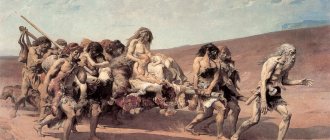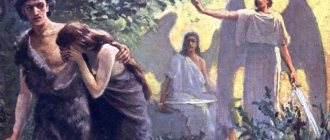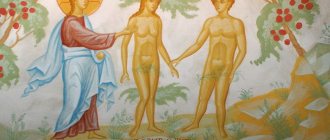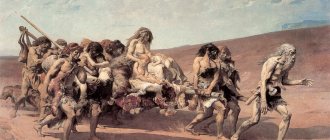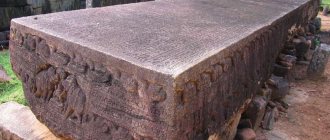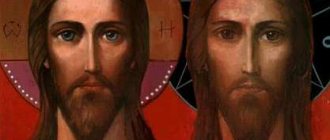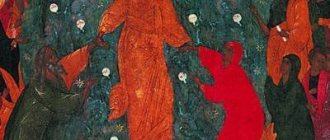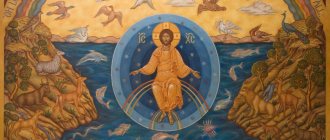The Bible is an amazing book that shows and reveals the heart of God. Its pages contain answers to many questions.
For example, where did man come from, that same man named Adam. The Bible describes the creation of the world and Adam on its very first pages - in the book of Genesis.
God's design was to create a man like Himself. Having molded the body of a man from the dust of the earth, the Creator breathed into him his life, which revived, transformed and clothed him in the glory of God.
His name is Adam, the first man on earth, the crown of God's creation, created in the image and likeness of God.
And God said: Let us make man in our image, after our likeness, and let them have dominion over the fish of the sea, and over the birds of the air, and over the cattle, and over all the earth, and over every creeping thing that moves on the earth. (Gen.1:26)
Adam was filled with the love, peace and joy of God; he had no spot or wrinkle and was perfect.
The Lord placed him in a wonderful garden called Eden, which was prepared for man and filled with everything necessary for a wonderful, happy life. It was a life without suffering, grief and tears - paradise in the truest sense of the word.
Adam and Eve: A Biblical Story
The story of the creation of man and his fall has remained one of the most important problems throughout the history of mankind. The plot of the Holy Scripture “Adam and Eve in the Bible” is still relevant today. After all, the issues he raises remain unresolved for many.
Adam and Eve after expulsion from Paradise (bas-relief on the wall of the Basilica of Notre-Dame de Fourviere, Lyon, France)
God created man at the very end of the creation of the World. The earth, like a royal abode, was prepared and decorated in advance for one who could take care of nature and be in communion with God. The Creator created man from the dust of the earth (clay) and breathed life into him. God created man in His image, rational and free, with an immortal soul (Gen. 1:27, Gen. 2:7). By this He elevated man above all previous creation. With our physical body we belong to the visible, material world. An immortal soul - to the invisible, spiritual world. The main goal of human existence is to be in complete harmony with God.
The name of the first man is Adam, which translates as “taken from the earth.” God placed Adam in the beautiful Garden of Eden. There, animals of all kinds came together to the first man. They came to Adam as a loving shepherd, without fear, and he gave each creature a name. So Adam took power over all living things and became the ruler of the Earth, like God (Gen. 2:19-20).
Foundation of Faith
Cain and Abel's responsibility was to fulfill the conditions of indemnity to correct the mistakes of their parents and thereby create the basis for the emergence of True Parents. The first step was to create a foundation of faith. God called Cain and Abel to make a sacrifice of the best fruits of the land and the best livestock, respectively. God rejected Cain's sacrifice but accepted Abel's. God's acceptance of Abel's sacrifice demonstrated Abel's success in building a foundation of faith (i.e., he acted in faith) and established him as the representative of sinless Adam in the second generation of the first family.
Creation of Eve
However, the man needed a friend and helper. Therefore, God took one of Adam’s ribs while he was sleeping and created a woman from it - Eve, the mother of all people (Genesis 2:21-23). The creation of woman from Adam's rib is interpreted both literally and allegorically. Moreover, both of these interpretations in the Orthodox consciousness do not contradict each other, but complement each other. In a figurative sense, the edge is interpreted as a facet, a side of human nature. Thus, woman was taken from Adam as another hypostasis of man. Metropolitan Hilarion (Alfeev) in his book “The Sacrament of Faith” points out that man is one in his hypostases, like the consubstantial and trinitarian God.
"Eve" means "living", "giving life". However, in paradise the first woman was nameless; Adam called her “wife.” Eve received her name after the Fall and expulsion from paradise, when she gave birth to Adam’s first child. The Creator commanded man and woman to be fruitful and populate the earth. Blessed by God to be together, Adam and Eve became the first family and the ancestors of all mankind. By creating Eve from Adam, God showed us that we all come from one beginning. Therefore, we must love and take care of each other.
Secrets and speculation
“The Creation of Adam” is a fresco that stands out clearly among Michelangelo’s other works. Why? Probably, this plot especially excited his thoughts, or maybe the author decided to leave some kind of “encrypted” message to people. Supporters of the second version express a variety of assumptions regarding the master’s plan.
It is no secret that Buonarroti was an expert in anatomy and the features of the human body. In 1990, the Journal of the American Medical Association published an article on this mural. But what do a work of art and medicine have in common?
An angel looks over God's shoulder, amazed at the beauty of man
According to physician Frank Meshberg, in the image of God and the outlines of the red fabric around him, Michelangelo reflected the anatomically accurate structure of the human brain. Perhaps the genius “hinted” to us that the basis for the creation of everything lies in the human mind?
Supporters of a slightly different assumption believe that the fresco depicts the process of birth. The red cloth around the Creator is shaped like a womb, and the blue ribbon resembles an umbilical cord. But doctor Davis Campos believes that the left side of Adam’s body has an “extra” rib, which later, as we know, became the basis for the creation of Eve.
There is a theory that in the image of God, the outlines of the red cloth around him, Michelangelo reflected the anatomically accurate structure of the human brain
“The Creation of Adam” is, without exaggeration, a great and mysterious work of art. Did Michelangelo Buonarroti leave any hidden symbols in it or did he simply try to reflect his own vision of the biblical story? We don’t have an exact answer to this question, and besides, everyone has their own opinion on this matter. However, “The Creation of Adam” never ceases to excite minds and arouse the admiration of people.
Why was woman created?
The wife was given to Adam as a companion, an assistant in the knowledge of God and improvement (Gen. 2:18), (Eccl. 4:9-10). Deacon Andrei Kuraev, in his lecture “Man and Woman in the Book of Genesis,” points out that Eve was created “to awaken in Adam a thirst for dialogue of love.” A man had to learn to love God through love for his wife.
Archpriest Andrei Tkachev in his lecture “Man in Paradise” says that when people get married, they seem to become Adam and Eve, who were blessed by God to be together in heaven. In marriage, the unity of the masculine and feminine principles that was in Adam even before their separation is restored. With mutual love, husband and wife complete each other’s existence and become one again. And in this totality of human nature, the image of God inherent in every person reaches its completion (Gen. 1:27), (Col. 3:10).
Initially, there was no evil in the world, and the earth was a paradise. Man was capable of communicating with God, and everything was in love and harmony with the Creator. Evil arose as a result of man's violation of this harmony.
Prophet of Allah
Having settled on earth, Adam (a.s.) was taught everything that a person needed to know to survive in those conditions. Over time, he and Havva began to have children. Their exact number is unknown; the only information that has reached us is that twins were constantly born. The first to be born to Adam (a.s.) and Havva were Qabil (Cain) and his sister, whose name is unknown. Then Habil (Abel) and his sister appeared. To continue the family line, the sons and daughters of Adam (a.s.) married each other. Thus, the number of people grew, and Adam (a.s.) was their prophet, who told them to worship the Creator alone.
Prophet Adam (a.s.) received revelations from the Lord of the worlds. After some time, scrolls (suhuf) were sent down to him, which contained the first written instructions in history to man from Allah. All people in the community of Prophet Adam (a.s.) were monotheists and worshiped the Almighty. However, this did not protect the first ummah from sin.
The Fall of Adam and Eve
God allowed Adam and Eve to eat the fruits of all the trees in the Garden of Eden. With the exception of one thing - the Tree of the Knowledge of Good and Evil. God warned the people that the consequence of breaking this commandment would be death (Gen. 2:16-17). Satan, in the form of a serpent, appeared to Eve and cunningly convinced her to try the fruits of the forbidden tree. The devil told her that by doing this, a person would not only not die, but would become equal to God. Eve succumbed to temptation and transgressed God’s commandment, after which she gave the fruit to Adam to try (Gen. 3:1-6).
All that Adam and Eve felt after their crime was shame before each other and fear of God. They began to cover their naked bodies with leaves and, when they heard the voice of the Creator, they tried to hide from him. The Almighty asked Adam and Eve accusatory questions and expected them to repent, but they began to justify themselves. Adam blamed Eve for the temptation, who, in turn, said that she was tempted by the serpent. By this stubbornness, people only worsened their falling away from God.
Expulsion from Paradise
Thus Adam and Hawwa became the inhabitants of Jannah. They were endowed with all the necessary benefits, but one tree was forbidden to them. The Almighty categorically forbade them to approach him and eat his fruits. Iblis, who was cursed because of his refusal to prostrate himself before man and vowed to lead all people astray until the Day of Judgment, got his chance. He began to persuade Adam and Eve to sin. Shaitan sought to convince them that this tree was haram for them only because it could make a person immortal. Iblis knew very well about people’s weak points and decided to put pressure on one of them.
Adam (a.s.) and Havva fell for Satan’s tricks and ate the fruits of the forbidden tree. After which the Almighty cast them both to the ground. At that moment, for the first time they felt the wrath of Allah, who deprived them of Paradise and separated them.
It would seem that they had everything, but the lack of gratitude and contentment with what they had led to the commission of sin. Unfortunately, this vice is also experienced by modern society, the beginning of which was laid by the first man.
Friday is considered a special day of the week among Muslims, also thanks to the Prophet Adam (a.s.). It is known that it was on Friday that he was created, introduced into Jannat and cast down to earth.
It is believed that Adam (a.s.) ended up in the territory of Ceylon, and Hawwa ended up on the Arabian Peninsula. For two centuries they wandered around the world and asked forgiveness from the Lord of the Worlds.
The bitter experience of the first of the people became the starting point of a person’s freedom of choice, as well as responsibility for his actions. From that moment on, Adam (a.s.) and Hawwa were wary of Iblis and sincerely repented of what they had done.
The Almighty showed His mercy and allowed them to reunite. After which Allah commanded Adam (a.s.) to build the Kaaba on the territory of modern Mecca and perform the Hajj to it. Thus began the prophetic mission of Adam (a.s.) on earth.
Consequences of the Fall
The Tree of the Knowledge of Good and Evil existed in paradise so that people, having fulfilled God’s only commandment, would show their obedience and desire for the Almighty. Thus, they would consciously renounce evil and choose good. By trusting their Creator and not accepting the devil, people would become even more like God. However, Adam and Eve listened to Satan and thereby broke their union with the Creator. In such a graceless state, Adam and Eve could no longer be in paradise; they “died” for it, as God warned. People were expelled from the Garden of Eden (Gen. 3:23).
Saint John Chrysostom in his “Sermon on the Beginning of the Holy Pentecost” says that
“Adam, without fasting, was expelled from paradise and received a command to cultivate the land that gave rise to thorns.”
Deacon Andrei Kuraev in his lecture “Man and Woman in the Book of Genesis” expresses the idea that what is happening is not so much an expulsion from God as a divorce, and “instead of a relationship of love with God comes a relationship of law.”
The sin of Adam and Eve deprived human nature of the source of Life and allowed corruption and death into it. Man was created for dominion over nature and communion with God. However, having moved away from Him and disrupted this harmony, he became a mortal being, subject to passions and illnesses.
The Monk Ephraim the Syrian in his “Interpretation of the Holy Scriptures” indicates that Adam and Eve before eating
“they knew good from experience, they only heard about evil; after eating, the opposite happened: they began to only hear about good things, but to experience bad things in practice, for God took away from them the glory with which they were invested, but sorrows that had not touched them before took possession of them.”
Saint Gregory of Nyssa in his work “On the Structure of Man” points out that sin is not a property of human nature, but a consequence of evasion from it, a distortion of the good that is innate to us.
Chapter 6. Adam - the first prophet of Monotheism
Adam, as we know, is the first man created by God (as the Torah and the Old Testament assure - in His image and likeness). At the same time, Adam, according to Muslim tradition, is at the same time the first of the greatest prophets, whose mission was to preach Monotheism. The Holy Quran says that the prophets of Monotheism were sent to each of the existing nations, and they were chosen from among these same nations. The total number of prophets in Islam amounts to many thousands (according to some Islamic theologians - up to 124 thousand), but only 25 of this number are considered Great Prophets, whose mission extended to all of humanity. And finally, only six prophets - Adam, Noh (Noah / Nuh / Noah), Ibrahim (Abraham / Abraham), Musa (Moses / Moshe), Isa (Jesus Christ) and Muhammad proclaimed new laws based on the commands of the Almighty.
According to Islamic traditions, a total of one hundred scrolls with Divine Revelations were given to the prophets, including: Adam - twenty-one, Shamu (Seth / Shem) - twenty-nine, Idris (Enoch) - thirty, Ibrahim (Abraham / Abraham) and Musa (Moses) /Moshe) - ten each.
So, Adam is considered the first Great Prophet. Together with his soul, he received from the Almighty some part of Divine knowledge, which elevated him above the genies. Only one of them, named Iblis , refused to bow to Adam and, moreover, spoke ill of him before the Almighty. This circumstance helps in deciphering his name - and bokha li (sa) - “he spoke dirty (badly) (soul).” This means that jinn also have a soul, so a more correct translation would be “this soul spoke dirty.”
It is widely believed that the name Adam was first mentioned in the Torah, its etymology being traced back to the Hebrew "red land", i.e. the clay from which he was created. Thus, the word Adam in Hebrew has two semantic meanings: the first, as already mentioned, is “red earth” or “clay,” and the second is “man.” In connection with the above, two interrelated questions arise: first, is the personal name Adam found in pre-biblical sources?; second - can the word Adam be considered Jewish (more broadly, Semitic) in origin?
The first question is very easy to answer. The name Adam is found in the genealogy of the rulers of Babylon from the dynasty of Hammurabi and the rulers of Assyria. As is known, both of them claimed descent from the same ancestors. Let us also recall that Hammurabi himself ruled from 1792 to 1750 BC, i.e. several centuries before the Hebrew ethnos was formed on the territory of ancient Palestine.
In the genealogy of the Babylonian king Hammurabi, the name of the second king is written as Tu-ub-ti-ya-mu-ta (Tubtiya-Amuta), and in the genealogy of the Assyrian kings the first ancestor is named Tudiyya, and the second is Adamu. Regarding this discrepancy, scientists have suggested that the Assyrian scribes, who used the same ancient written sources as the Babylonian ones when compiling the royal genealogy, made one mistake - they interpreted the title of the king as a personal name and therefore an “extra” ancestor was added to their genealogy.
As a result, we get two similar names: according to the Babylonian version - Tubtiya-Amuta, according to the Assyrian - Tudiyya-Adamu. It is also quite obvious that in the Babylonian genealogy the ancient scribes made an incorrect arrangement of individual syllables (metathesis), as a result of which the ending -Adamu turned into -Amut . According to D. Rohl, it is this metathesis that turns the name Adam into a common Semitic word meaning “earth/red.”
Let us also note that, according to Babylonian genealogy, 24 generations passed from King Tubtiyya-Amut to King Hammurabi, i.e. according to the most conservative estimates, more than 700 years have passed. Consequently, Tubtiya-Amuta (Tudiyya-Adamu in Assyrian transcription) lived around the middle of the 3rd millennium BC, and this is the heyday of the Sumerian civilization, whose influence at that time covered all of Mesopotamia.
It has been suggested in the literature that the name Tudiyya-Adamu can be translated as "[God's] Beloved Adam." But if Tudiyya is a title mistaken by the Assyrian scribes for a personal name, then it must mean "Beloved of God." The existence of such a title is quite possible (in a later period, eastern rulers willingly called themselves “favorite of the gods”). Unfortunately, we do not know what exactly this interpretation of the word Tudiyya/Tubtiya . For our part, we note that Tudiyya turtan , widespread in the Ancient East , as well as with the Khazar title tudun . The first title served to designate the commander, the second - the governor of a separate region. Both titles ( turtan and tudun ), in our opinion, come from the Chechen (Nokhchi) tur da - literally “father (owner) of the sword.”
The very version that the name Adam appeared in Hebrew from the designation of red clay immediately indicates that the semantic meaning of “man” appeared later, i.e. it is secondary. Meanwhile, it is precisely established that in the much more ancient Sumerian language the word adam was used in the meaning of “people”, “humanity”. In the modern Chechen (Nokhchi) language, the word adam is also used in the meaning of “person” (plural adamash - “people”). From it a number of new words are formed, for example, adamalla - “humanity”.
Elementary logic dictates that the name of the first person should have had the semantic meaning “man,” and the interpretation “red clay” appeared to him only when translating ancient Sumerian texts into Hebrew. Moreover, the basis of the second interpretation is simple consonance.
However, we can give another example of how, when translating the Hebrew text of the Bible, a substitution of concepts occurred. Thus, everyone who has read the Bible knows that Cain is called a farmer - this is how translators interpret the Hebrew expression obed adamah , used in relation to Cain: “Abel tended the flocks, and Cain tilled the land.”[81] However, we know that the Hebrew compilers of the Torah quite often included a literal translation of Sumerian words into its text, and later translators of the Bible, unaware of this, tried to interpret them from the Hebrew language. Such a copy from Sumerian, in our opinion, is the expression obed adamah , which is correctly understood in the modern Chechen (Nokhchi) language - a(i) vedda Adamah , which literally means “he fled from Adam” or “he fled from people” . There is probably no need to remind you that Cain really fled from his parent Adam and for some time generally hid from people.
It must be assumed that the long-prevailing belief that the Torah and the Old Testament were written exclusively in Hebrew deliberately strengthened the early Oriental researchers in the opinion that the most ancient texts of this region could only be written in Semitic. As a result, the discovery of the Sumerian and Hurrian languages, which are not part of the Semitic language family, at one time became a genuine scientific sensation. However, to date, a tendency is clearly visible in the scientific literature aimed at “antiquating” the Semitic languages at the expense of the same Sumerian and Hurrian languages, which allegedly quickly disappeared from the historical arena, leaving almost no traces in the Semitic languages.
Moreover, the influence of Semitic languages on these already extinct languages is strongly emphasized. Surprisingly, the word adam . Meanwhile, some cuneiform texts mention a certain priest - the founder of the oldest known temple, discovered during excavations of the Sumerian city of Eridu. His name is usually read as Adapa/Adap . A simple transformation of the final consonant -p into -m (which is quite consistent with the rules of linguistic transformation) turns this name into the well-known biblical Adam .
However, the similarities between the biblical Adam and the Sumerian Adapa do not end there. Researchers, having analyzed the Sumerian legend about Adapa, have identified a number of direct parallels with the biblical legend about Adam. So, Adap, like Adam, had to go through the test of obedience to the God who created him. Moreover, the test turned out to be related to food. Both heroes (Sumerian and biblical) were unable to pass it and, as a result, lost their immortality. Finally, Adap, like Adam, belonged to the antediluvian generation of people.
We also had occasion to point out that, taking into account the already mentioned transformation of individual phonemes, the Sumerian name, usually read as Etana , can receive the reading Adam - E(A)t(d)an(m)a .
Sumerian tradition considers Etana one of the first post-flood rulers to be credited with an unnatural length of life and reign. Thus, King Etana allegedly ruled in Kish for 1560 or 1500 years. According to the same Sumerian tradition, the antediluvian kings lived even longer. There were eight of them in total, and the total period of their reign is calculated by the Sumerian King List at 241,200 years.
And in this, by the way, certain analogies with the Holy Scriptures are revealed. As is known, the patriarchs who lived before the flood were distinguished by rare longevity. For example, Adam himself lived 930 years, and Methuselah (Methuselah), who lived 969 years, is considered the longest-living record holder.
But there is another coincidence. The Sumerian King List speaks of eight kings who reigned before the Flood. As for the Bible, it contains two lists of patriarchs who lived before the flood, and in one of them (going through Cain, the first son of Adam) there are also eight names, and in the second (going through Seth, the third son of Adam, born after the death of the second son of Abel) - ten.
So, the first biblical genealogy contains the following names: 1. Adam, 2. Cain, 3. Enoch, 4. Irad, 5. Mechiael, 6. Methuselah, 7. Lamech, who had three sons: Jabal, Jubal and Tubal-Cain .
The second biblical genealogy reflects, as already noted, the succession of ten generations: 1. Adam, 2. Seth, 3. Enos, 4. Cainan, 5. Maleleel, 6. Jared, 7. Enoch, 8. Methuselah, 9. Lamech, 10 Noah
The British researcher and archaeologist D. Roll, already mentioned by us, conducted a comparative analysis of the names in the biblical list of antediluvian patriarchs, the genealogy of the Babylonian king Hammurabi and the genealogy of the Assyrian kings. As a result, he discovered that the biblical names Adam, Cain, Enoch, Lamech, Tubal and Noah have analogies in the two mentioned royal genealogies, and all the differences are explained by the imperfection of the Sumerian word-syllabary writing system, which left room for different readings of the same set of syllabics characters. The fact is that in Sumerian texts words were separated from each other by vertical and horizontal lines. Thus, each word was a set of cuneiform characters enclosed in a separate “cell-capsule”, and the order of syllables in the “cell-capsule” could be arbitrary. Those. It was possible to read the word absolutely correctly only if you knew the language in which the inscription was written. As a result, scribes of subsequent eras, who copied Sumerian texts but did not know the Sumerian language itself, often made incorrect placement of syllable signs, which led to numerous metatheses, and the words themselves acquired a sound that was not characteristic of the Sumerian language.
For our research in this case, what is much more important is not this circumstance (incorrect reproduction of Sumerian texts), but the very fact of the widespread use of the oldest Sumerian texts by the Hebrew compilers of the Bible. Thus, we can assert that the Torah and the Old Testament reflect not only (and not so much) ancient Jewish traditions, but reproduce the Sumerian (in other words, the ancient Chechen (Nokhchi) tradition.
The genealogy of the antediluvian patriarchs given in the Bible contains a number of very interesting analogies with ancient Sumer. Thus, according to the Sumerian tradition, one of the oldest cities on Earth was Eridu , whose name contains the biblical eponym Irad (son of Enoch). In addition, there is a text in the Bible that allows us to conclude that the first city on earth was built by Enoch (and not Cain) and named by him after his son - Irad or Eris.
But that's not all. In ancient Sumer there was a city that bore the name of Enoch himself. This city in the Bible is called Ur of the Chaldeans (it was from here that the family of the prophet Ibrahim (Abraham/Abraham) came). The Hebrew name Ur is a truncated tracing from the earlier Akkadian name Uruk . Meanwhile, the true Sumerian name of this city is UruUnuki , where the word uru means actually "city". But Unuki is the Sumerian version of the name Enoch. Knowledge of the rules of language transcription allows us to prove that the Hebrew name Enoch in Sumerian should have sounded like Unuk or Unug (the sound y of the Sumerian words in Hebrew transcription changed to and/ e , and the sound k turned into the sound x ). As a result, the Sumerian name Unuk was pronounced by the ancient Jews as Inuch/Enoch ... Consequently, the name UruUnuki means “city of Unuki” or (using the biblical pronunciation) “city of Enoch.”
However, as mentioned above, the reliability of the correct reading of Sumerian texts still remains very low. Therefore we cannot fully insist on the correct pronunciation in the UruUnuki . The only thing that is beyond doubt is that the mentioned city originally bore the name of the biblical Enoch.
We also proved that the biblical text that has survived to this day contains many direct borrowings from the ancient Chechen (Nokhchi) language. Thanks to this, we can assume that the real Sumerian sound was still closer to the form recorded in the Bible. In addition, we can even offer our own version of the decoding of the name Enoch , as coming from Ela Nokh - “prophet Noch/Noah”.
But this does not exhaust the list of biblical names that served as eponyms for Sumerian cities. Another antediluvian (according to Sumerian tradition) city is Badtibira , the name of which scientists translate as “Settlement of a metalsmith (blacksmith).” The most famous biblical character, whose name translates as “blacksmith” is Cain, but more interesting to us is one of his direct descendants, who bears the complex name Tubalcain . D. Rol, paying special attention to this name, also noticed that the soft consonant sound “l” in the root of the name Tubal - T-v(b)-l , in Hebrew very often replaces the “r” in the Sumerian language. Having made this simple replacement, he received the root stem T-b-r , derived from the Sumerian Tibir in the meaning of “metal worker” or “blacksmith”. Thus, the name Tubalkain turned out to consist of two words (Sumerian and Hebrew) that have the same meaning - “blacksmith”. Apparently, one of the compilers of the Bible, trying to make the unfamiliar Sumerian word-name Tibir ( Tubal in Hebrew pronunciation) more understandable to his compatriots, added its exact translation to it. Later scribes recorded these two side-by-side word-names as one, resulting in the compound name Tubalcain . Therefore, a direct connection can be considered established between the biblical name Tubalcain and the Sumerian city of Badtibira.
Thus, in the Bible itself there are indications of a direct connection between the antediluvian patriarchs and the oldest civilization on Earth - Sumerian. And what is very important for us is that the above facts are already enough to refute the widespread opinion that all ancient prophets (starting with Adam) came exclusively from a Jewish or Semitic environment.
In search of additional evidence in favor of the thesis put forward above, we can again turn to the person of the biblical Adam. Let us remember that the first man was created in the image and likeness of God himself, and he was destined to become the ruler of the earth, the representative of God on Earth. It is no coincidence, therefore, that in a number of ancient Canaanite texts the name Adam is used in direct association with the ancient name of the Most High - El . These are the texts where the Almighty, called El/El/Ilu , is also called Ab-Adam - “father of man” or more broadly “father of humanity” (in ancient and modern Semitic languages the word prefix ab/abu carries the semantic load of “father "). The Chechen analogue of the Semitic ab/abu is the word yes , which, however, in the Chechen (Nokhchi) language has a broader meaning: not only “father”, but also “lord”, “lord”, “master” (depending on the context) . This circumstance perfectly reveals the mechanism of formation of the modern Chechen Dela/Del/Diel - “God”, which appeared thanks to the addition of Da + El in the original meaning of “Lord God” or “God of the Fathers”, which was supposed to once again emphasize the absolute power of the Almighty.
The original place of residence of Adam and his wife Chava (Eve) is the Garden of Eden, called Eden (Eden - in the Torah). The description of Eden itself takes up very little space in the Holy Scriptures: “8Then the Most High, the Eternal, planted a garden in the east, in Eden, and settled there the man whom He had created. 9 The Most High, the Eternal, brought forth from the earth all kinds of trees, pleasing to the eye and good for food. In the middle of the garden grew the tree of life and the tree of the knowledge of good and evil.
10From Eden a river flowed, watering the garden, and then it divided into four streams. The first is called Pishon, which flows around all the land of Havilah, where there is gold... 13 The second river is called Gihon, which flows around all the land of Cush. The third river is called the Tigris: it flows east of Assyria. And the fourth river is the Euphrates.”[82]
At one time, not only theologians, but also scientists of various specialties spent a lot of effort trying to determine the exact location of Eden. Thus, at one time, most researchers were inclined to believe that the Garden of Eden was located between the Tigris and Euphrates rivers. Recently, the point of view according to which Eden is localized in one of the intermountain valleys in the northeast of modern Iran has become increasingly popular.
But we are not interested in the location of the Garden of Eden, but in the key words that would allow us to confidently draw a parallel between the biblical text and the Chechen (Nokhchi) language. In this sense, we are interested in the names of the rivers into which the water flow coming out of Eden is divided. Of these four rivers, two are confidently associated with the Euphrates and the Tigris, and therefore all modern translators of the Holy Scriptures use these names, although the original says Prat or Perat (Euphrates) and Khidekel/Khiddekel (Tigris). The other two names (Pishon/Pichon and Gihon) are subject to quite heated debate and are therefore given close to the sound of the original text of the Torah.
It is relatively easy to unravel the semantic content of the name Khidekel/Khiddekel (Tiger). At its basis, some Chechen researchers see the Chechen expression hi ida k1el - “water running (rushing) down,” which seems incorrect to us. Let us remember that the Tigris is one of two rivers between which there was a vast region called Mesopotamia or Mesopotamia by the ancient Greeks. Therefore, for the name Khidekel/Khiddekel, hi dekaadella seems more convincing as an initial form , i.e. "interfluve".
Let us note that most modern researchers consider Khidekel/Khiddekel to be the Hebrew name for the Tigris, which is often contrasted with the Sumerian name of the same river - Idiglat . But this word can also be literally translated from the Chechen (Nokhchi) language: and dika latta - “this is a good land.” Let us remember that the Tigris and Euphrates flowed through fertile lands, for the successful cultivation of which the only thing missing was water, which came through canals diverted from these rivers.
The second great river of Mesopotamia in Tora is called Prat/Perat. The ancient Greeks pronounced the name as Euphrates . It is this pronunciation that has entered modern European languages. But, for example, the Arabs know her as Firat . As for the ancient Sumerian name, modern linguists reproduce it as Buranun . The discrepancy in the name of the same river clearly shows, on the one hand, the unreliability of the phonetic reproduction of Sumerian (and in general all cuneiform) texts, and on the other hand, it can serve as a clear example of sound transformation in various languages. As we can see, the root basis of the name of the river -rat- , while the initial sound in different languages is reproduced in different variations: P-, Evf-, F-, B- . All this makes it extremely difficult to decipher the name of the river from the Chechen (Nokhchi) language. The most suitable, from our point of view, seems to be the option associated with the Chechen word Ekhart . In modern Chechen language it is most often used to mean “the afterlife,” but it can also mean “paradise.” Let's not forget that the Euphrates, according to the ideas of the ancients, flowed out of paradise, so it could well be called the “paradise river.”
The Pishon/Pichon River is known to flow around the land of Havilah. Both of these names are worth taking a closer look at. The etymology of the hydronym Fison/Pichon X- should come first . Those. the correct pronunciation is Khishon , where the initial Hi- means “water”, “river” in Chechen. Currently, the Fison/Pichon is most often understood to be the Wizhun River, the source of which is located south of Lake Urmia.
As for the name of the country Havilah , in this case there is a small metathesis, correcting which we get Vakhila - literally “live” in Chechen. Such a name, without a doubt, should have meant a country or area very favorable for life, rich in natural resources. Apparently, it is no coincidence that the biblical text specifically speaks of the wealth of this country in various natural minerals.
Finally, the fourth river, the sources of which were in the Garden of Eden - Gihon , whose name appears there as a typical inverted word. When reading backwards, we get Hohig(x) . The ending here is clearly unreliable, which allows us to build an association with the Chechen Nokh hi - “the river Nokha (Noya).” Let us add to this that the biblical Gihon is quite confidently identified as the modern Araks River, which in Persia was recently called Jihon.
In this regard, it would be appropriate to recall that the sources of the Tigris, Euphrates, Araks and Uizhun are located on the territory of historical Urartu, a country known in the Bible as Ararat. This is where Noah's Ark will eventually land. Thus, we find in the Bible a direct indication of a very significant circumstance: the initial settlement of the Earth by people began in the Caucasus, from an area whose ancient population (as historical science has clearly established) was genetically related to modern Chechens. And it was from this same territory that the secondary settlement of humanity began, as the descendants of the prophet Noch (Noah).
The Bible is completely silent about the question of what language Adam and Havva (Eve) spoke, but it absolutely accurately records the moment of the appearance of different languages - after the Flood (we will dwell on this point in more detail).
As for the Islamic tradition, it proceeds from the fact that the prophet Adam spoke many languages, which later became the languages of the peoples descended from him. Thus, Islam declares the equality of languages and recognizes the value and right of each of them to exist.
Also, the Koran itself does not contain a more or less detailed biography of Adam and Hawwa (Eve), although there are many comments on this topic compiled by Islamic theologians, as well as legends associated with them, defined by modern researchers as post-Koranic, i.e. compiled in addition to the Koran: “In these legends, naturally, one can feel the influence of Arabic pre-Islamic tales about Adam and Hawa, and the influence of biblical images, which is not surprising, since the Torah (at-Taura), which sets out the biblical version of the story of Adam and Eve, considered by Islam to be one of the sacred scriptures and is mentioned many times and even quoted in the Koran.
At the same time, the post-Koranic legend gives this Middle Eastern legend exclusively Arabic features: the meeting place of Adam and Hawwa, and the place where they lived their lives, and their graves, located in Arabia. And even the clay for the creation of Adam was Arabian, taken somewhere between Mecca and Yemen. Their relationship was also sensual in the Arabic way.
But, despite the differences that exist in them, both legends about Adam - both the biblical and the Koranic - belong to a single cultural space of the ancient history of mankind, called the “Middle East”....[83]
Indeed, the Bible and the Koran record only the very fact of the expulsion of Adam and Hawwa (Eve) from the Garden of Eden, and the post-Koranic legend claims that Adam, cast out from heaven, ended up on the island of Ceylon, and Hawwah ended up in the Arabian region of Hijaz. For almost a hundred years they then searched for each other until they met in the place where Mecca later arose. There they built the first structure of the Kaaba, and there they received a transparent stone sent down from heaven from the throne of Allah, which subsequently darkened from human sins and turned into the Black Stone of the Kaaba. Adam and Havva were initially buried there in Mecca, with a short time interval, and after the flood, Adam’s ashes were allegedly transferred to Jerusalem. However, there are legends with a different selection of details, but in general they all form the belief that the life of the first prophet was closely connected with Arabia, and he himself begins to be directly associated with the Arabs.
At the same time, the biblical legend gives the listener the impression that Adam was a Jew.
Meanwhile, as mentioned above, neither the Bible nor the Koran contains any indications that would indicate the ethnicity of the first man and the first prophet. What is quite natural is that Monotheism unites all people, spiritually raising them above ethnic differences: “13. O people! We created you from (one) male and (one) female and made you nations and tribes so that you might know each other. The most worthy of you before Allah is the most God-fearing.”[84]
Accordingly, our research is not aimed at satisfying a primitive sense of nationalism, not at exalting one nation over others, but at establishing a truth that helps each people realize their own destiny.
Having familiarized ourselves with the content of the Holy Scriptures, we can conclude that in the antediluvian time all humanity was one people speaking one language. The Bible absolutely accurately records the time of the emergence of linguistic diversity - this happened already in the post-flood time, when the multiplied descendants of Noah (Noah/Nuh/Noach) decided to challenge the Almighty by building a tower rising to the skies. Islamic scholars confirm what is said in the Bible. And although, according to Muslim tradition, Adam mastered all the languages of mankind (or, according to another version, 700 languages), nothing indicates that his immediate descendants had the same gift. There is no doubt that Adam and his descendants up to Noah (Noah/Nuh/Noah) spoke the same language.
Did this language disappear during the Babylonian Pandemonium? The Holy Scriptures speak only about the emergence of new languages, but not a word about the fact that the language of Adam ceased to exist. It is also obvious that in the ten generations that followed from Adam to Noah (Noah/Noach/Nuh), the language of the first people simply would not have had time to accumulate enough changes to make the emergence of new languages possible. Moreover, the extraordinary longevity of the first people is rather an argument in favor of preserving the first language than against it. It is known that changes in language accumulate from generation to generation until they transform into a new quality, which is expressed in the first appearance of dialect differences, and then the final separation of new languages occurs. Having mastered the language of their parents in childhood, the children of Adam and Havva (Eve) spoke it until the end of their lives. But the fact of the matter is that the ancestors of humanity lived long enough to directly pass on their language not only to their children, but also to their descendants, at least up to the eighth generation inclusive. Simple calculations show that Adam lived until the birth of Lamech and at that time he was 872 years old (in total, according to the Bible, Adam lived 930 years). And Lamech became the father of Noch (Noah/Nuh/Noah), who happened to experience worldwide sweat.
Thus, we see that the first language of mankind had all the conditions to survive almost unchanged until Noah (Noah/Nuh/Noah).
Muslim theologians are also unanimous in their opinion that the Divine gift of prophecy was successively passed on from one generation of his descendants to the next until Noah (Noah/Nuh/Noah). It is unknown how many children Adam and Havva (Eve) had. In the Bible, only three sons of Adam are named: Cain (Kabil/Khabil), Abel (Habil/Khabil) and Seth (Sham/Shem/Sheth/Shit), but it is said that after the birth of Seth he (Adam) had more sons and daughters.
In passing, we note that the Bible translators do not translate the names of the first two sons of Adam in any way, limiting themselves to indicating that the name Cain in the original language sounds similar to the word meaning “to acquire.” But these names can be interpreted quite convincingly based on the modern Chechen (Nokhchi) language. Thus, the personal name Kabil (Khabil/Cain) in its original form has the Chechen expression kaa di , where ka means “sin”, and di means “did”, “committed”. In general, we get the literal meaning - “committed a sin.” In this regard, it is worth explaining that it was the descendants of Qabila (Khabila/Cain) who were the first among people to fall into the sin of idolatry. After the death of Kabila (Khabila/Cain), they did not bury his body, but, having embalmed it, placed the corpse in a niche carved out of stone and began to worship him.
As for the personal name Habil (Khyabil/Abel) , it is a transformed Chechen expression akh wine - literally “you killed,” which directly indicates his tragic fate.
Post-Koranic traditions agree that Adam left behind numerous offspring, but add that his first children were born to him as twins: a boy and a girl. It is very characteristic that if the Torah and the Bible give a genealogy of the descendants of Adam, originating from Cain and Seth, then the Muslim antediluvian genealogy is entirely built on the line of Shama / Shem / Shisa / Seth, with the significant addition that all of them (although and to varying degrees) Divine Revelation was given and they all ruled the community of the first people. So, it was the third son of Adam and Havva (Eve) named Sham/Shem/Shis/Sif who received the Divine gift of prophecy and during his lifetime ruled the community of believers. After the death of Sham/Shem/Shish/Seth, the rule passed to his son Anush (Enosh), who in turn passed it on to his son named Kainan (Khinan/Keinan). Then the duties of the ruler successively pass to Mahlail (Mahalalel) and Yard (Yered).
All of the descendants of Adam listed above are not among the Great Prophets, perhaps because they did not have to directly deal with idolaters. The first Great Prophet, after Adam, whose name is mentioned in the Koran, was Idris (Enoch/Hanoch), the son of Yard. He was the first to master writing, showed people how to sew clothes, and laid the foundations of such sciences as astronomy and arithmetic. In addition, Idris preached Monotheism among the descendants of Qabila (Cain/Khabila), who fell into idolatry. Idris was a man so perfect and God-fearing that he was awarded the honor of being ascended to heaven alive and beholding paradise.
Before the next Great Prophet Noh (Noah/Nuh/Noah) came to the world, the community of believers was ruled one after another by Mutavshalah (Matushalih/Methuselah/Methuselah) and Lamak (Lamk/Lemech/Lamech).
We see, therefore, that in antediluvian times the gift of Divine Prophecy passed from generation to generation within the framework of one lineage, going back directly to the third son of the prophet Adam. At the same time, representatives of the Shama/Shema/Shisa/Sifah clan are carriers of the same linguistic community and members of the same religious community, opposing the idolaters, the descendants of Kabila (Cain).
First words
The Koran compares the method of birth of the prophet Adam and the prophet Isa. Allah breathed life into Adam. When his soul entered his body, Adam sneezed and said the words “Praise be to Allah!”, and in response to these words, the Almighty endowed the first man with His mercy.
The Almighty instructed the first man to greet the angels who were sitting nearby, and Adam said the words: “Assalamu alaikum,” which meant “Peace be with you!” In response to this, the angels responded with the words “And to you may peace and mercy and blessings of Allah be upon you.” With these words, from that very day, all the Lord's subordinates greet each other. The Almighty instructed the first man he created and all his descendants to spread peace.
Conversation between angels and Allah regarding the creation of man
God appointed man on earth as his deputy or caliph. The angels turned to Allah with the question: “ Will You install on it someone who will commit wickedness and shed blood there?” " To this, the Almighty Lord replied: “ Truly, I know what you do not know ” (Surah Al-Baqarah (The Cow), verse 30).
After this, the Almighty spiritualized Adam, and then demonstrated his mental abilities to the angels and commanded him to say the names of the angels, after which he called their names. The Lord also taught him the names of all things and languages. And then Allah said: “ Didn’t I tell you that I know what is hidden on earth and in the heavens, and I know what you reveal and what you hide? "(Surah Al-Baqarah (The Cow), verse 33).
